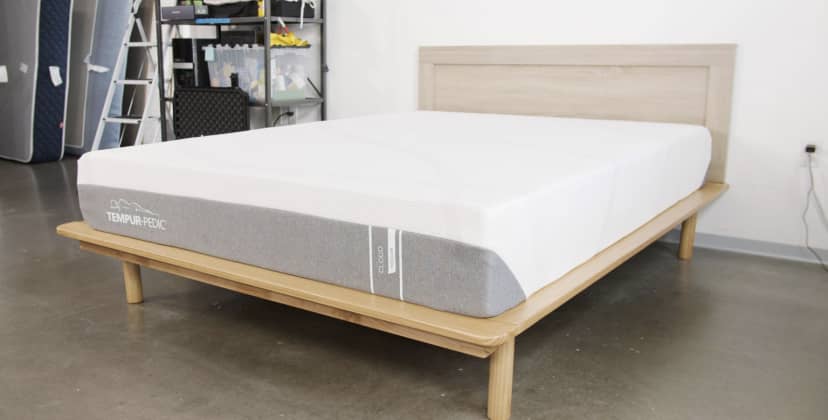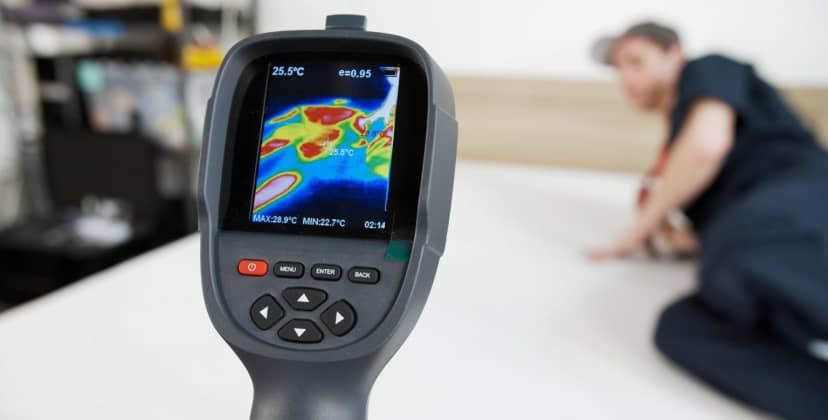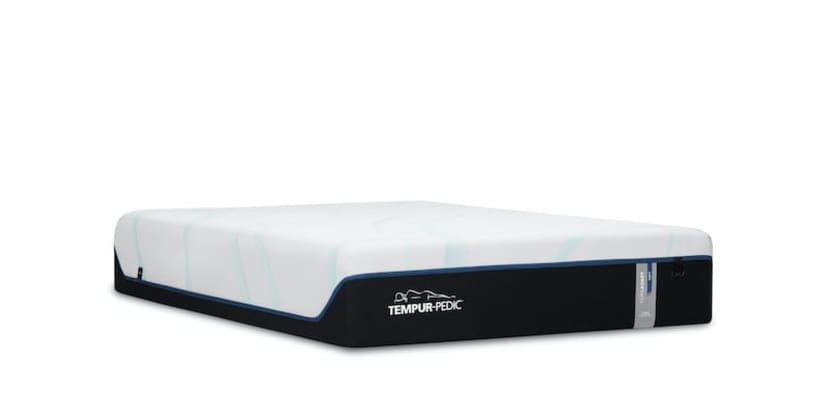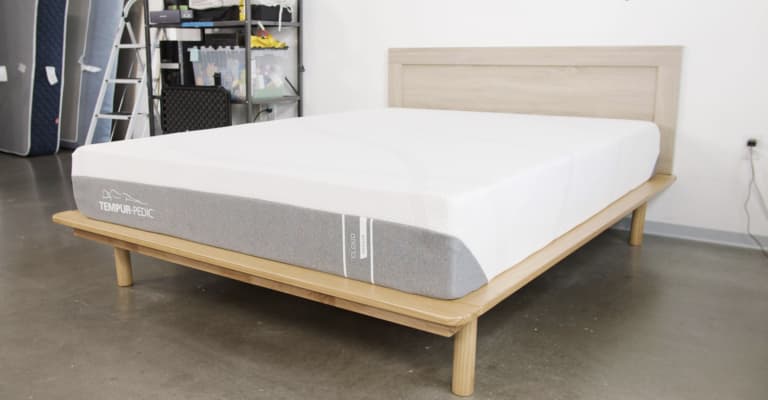When you buy through our links, we may earn a commission. Products or services may be offered by an affiliated entity. Learn more.
Tempur-Pedic launched in 1992, using material developed based on NASA’s research on a new kind of foam to use in spacecraft seats. The company decided that the material that was designed to cushion and support astronauts during takeoff could also fit the needs of sleepers. This material is now commonly known as memory foam, earning Tempur-Pedic the distinction of popularizing memory foam mattresses. After merging with Sealy in 2012, Tempur-Pedic became part of one of the world’s largest mattress companies.
- Our top pick, the Tempur-Pedic TEMPUR-Adapt, uses high-end memory foam to cradle the lumbar spine. We found this alleviates pressure in the lower back and enhances support.
- Memory foam’s unique combination of contouring and support can be an ideal match for back sleepers. Read more in our in-depth buying guide.
- Want to get details on Tempur-Pedic mattresses? Learn about our top picks for back sleepers.
Our Top Picks
-
Best Overall – Tempur-Pedic TEMPUR-Adapt
View Details
-
Best Value – Tempur-Pedic TEMPUR-Cloud
View Details
-
Most Comfortable – Tempur-Pedic TEMPUR-LuxeAdapt
View Details
Swipe for more
Best Overall
Tempur-Pedic TEMPUR-Adapt
8.0 /10
Test Lab Score
$2,199 from Tempur-Pedic (queen)
$2,199 from Tempur-Pedic (queen)
The Tempur-Adapt Mattress takes the top spot for the best Tempur-Pedic mattress for back sleepers. It features all of the best of Tempur-Pedic’s pressure-relieving foam, and it’s available in both a foam or hybrid option so that you can choose the model that optimizes your support.

Credit: Sleep Foundation Test Lab
Price
$1,999
Mattress Type
Foam
Firmness Options
Medium (5)
Trial Period
90 nights (30-night requirement), $175 return fee
At a Glance
- Who It’s Best For: Back sleepers under 230 pounds, as well as couples.
- Feel: Medium (5) with noticeable hug around the heavier parts of the body. Enhanced bounciness that can give extra support under the midsection of back sleepers.
- What It’s Made Of: The top two layers are made of TEMPUR memory foam. In the all-foam model, the bottom layer is dense polyfoam, and in the hybrid model, it’s an array of pocketed innerspring coils.
- What We Don’t Like: Expensive. Too soft for some back sleepers, especially those over 230 pounds.
Scoring Breakdown
The following ratings show how suitable this mattress is for different sleeping positions and sleeper weights. These scores are determined by how well the mattress supports and relieves pressure for each sleeper type.
Best Value
Tempur-Pedic TEMPUR-Cloud
7.7 /10
Test Lab Score
30% off with code: CLOUD30
30% off with code: CLOUD30
If you want the benefits of TEMPUR foam but are working with a limited budget, the Tempur-Cloud is right in your wheelhouse. With its more affordable price-point, it provides excellent value to back sleepers who need pressure relief around the lumbar spine to prevent waking up with aches and pains.




Credit: Sleep Foundation Test Lab
Price
$1,399
Mattress Type
Foam
Firmness Options
Medium (5)
Trial Period
90 nights (30-night requirement, $175 return fee)
At a Glance
- Who It’s Best For: Back sleepers under 130 pounds.
- Feel: Medium (5) with significant conforming properties without feeling swallowed up by the mattress.
- What It’s Made Of: The top layer is a thin TEMPUR comfort foam that sits above a thicker layer of TEMPUR support foam. The base layer is made with high-density polyfoam. For an added charge, you can upgrade to the hybrid model with innerspring coils in the support core.
- What We Don’t Like: Charge for return shipping. Not supportive enough for back sleepers over 230 pounds.
Scoring Breakdown
The following ratings show how suitable this mattress is for different sleeping positions and sleeper weights. These scores are determined by how well the mattress supports and relieves pressure for each sleeper type.
Most Comfortable
Tempur-Pedic TEMPUR-LuxeAdapt
8.2 /10
Test Lab Score
$4,199 from Tempur-Pedic (queen)
$4,199 from Tempur-Pedic (queen)
For back sleepers looking for the highest level of comfort, the Tempur-LuxeAdapt is our top recommendation. It includes multiple layers of top-flight TEMPUR foam with a proprietary design that gives extra support to five key support zones. Available in three firmness levels, it gives options for back sleepers to find the spinal support they need.

Price
$3,999
Mattress Type
Foam
Firmness Options
Soft (3), Firm (7)
Trial Period
90 nights (30-night requirement)
At a Glance
- Who It’s Best For
- Those over 130 pounds (firm), and back sleepers under 130 pounds (soft or medium hybrid).
- Feel: Soft (3), medium (5), and firm (7) options. The mattress cradles key pressure points for superior comfort, and the medium hybrid gives a touch of springiness.
- What It’s Made Of: Thick quilted cover that’s treated to enhance temperature regulation. The top layer is 2.5 inches of gel-infused memory foam, followed by a 6-inch layer of metal coils, resting on 1 inch of dense foam.
- What We Don’t Like: Not ideal for back and stomach sleepers over 230 pounds.
Scoring Breakdown
The following ratings show how suitable this mattress is for different sleeping positions and sleeper weights. These scores are determined by how well the mattress supports and relieves pressure for each sleeper type.
The Best Deals of the Week
-
Save $166
—
Brooklyn Bedding CopperFlex Memory Foam
$499 (List Price $665) -
Save $475
—
Helix Midnight Luxe
$1,899 (List Price $2,374) -
Save $2,452
—
Nectar Adjustable Bundle
$1,398 (List Price $3,850) -
Save $300
—
WinkBed
$1,499 (List Price $1,799) -
Save $932
—
DreamCloud Mattress
$599 (List Price $1,531)
Best Overall
Tempur-Pedic TEMPUR-Adapt
8.0 /10
Test Lab Score
$2,199 from Tempur-Pedic (queen)
Shop NowA high-performance mattress from Tempur-Pedic that comforts and supports back sleepers.
See More Details

Credit: Sleep Foundation Test Lab
Best Value
Tempur-Pedic TEMPUR-Cloud
7.7 /10
Test Lab Score
30% off with code: CLOUD30
Shop NowA solid value for back sleepers seeking the comfort and cushioning of a Tempur-Pedic mattress.
See More Details

Credit: Sleep Foundation Test Lab
Most Comfortable
Tempur-Pedic TEMPUR-LuxeAdapt
8.2 /10
Test Lab Score
$4,199 from Tempur-Pedic (queen)
Shop NowAn extremely comfortable Tempur-Pedic mattress offering back sleepers a choice of firmness options.
See More Details

Back Sleeping Explained
While back sleeping doesn’t enjoy the widespread popularity of side sleeping, around 10% of sleepers swear by it.
Back sleepers may notice a wide range of potential benefits, including the following.
- Spinal alignment. With a sufficiently supportive and contouring mattress, back sleeping usually supports the spine’s natural alignment, which could lead to fewer aches and pains.
- Fewer facial wrinkles. Back sleepers are thought to be less likely to develop facial wrinkles as a result of their sleep position. Side sleeping and stomach sleeping put pressure on the face, which could lead to wrinkling.
However, sleeping on your back can also have some potential drawbacks:
- Snoring and aggravated sleep apnea. When you fall asleep, your muscles relax. A back sleeper’s tongue may fall to the back of their mouth and their airway may compress, leading to snoring. This can be particularly problematic for those with sleep apnea. However, many back sleepers find relief from snoring by using a wedge pillow or adjustable bed to elevate their upper body.
- Pregnancy issues. The added weight around a pregnant woman’s midsection can make back sleeping uncomfortable and contribute to lower back pain. Experts advise against this sleep position during pregnancy because it can also restrict blood flow, potentially diminishing the nutrients and oxygen that the fetus receives.
- Aches and pains. Some sleepers experience aches and pains when sleeping on their backs. Neck pain may develop if the pillow is too thin or too thick. Some individuals also suffer from back or hip pain as a result of the sleep position, which can often be resolved by placing a pillow or rolled towel under the knees.
- Acid reflux. Lying on the back without a sufficiently supportive pillow could allow stomach acid to creep up into the esophagus. However, a wedge pillow that elevates the upper body can reduce the risk since gravity helps keep the sleeper’s stomach contents in place.
How to Choose a Tempur-Pedic Mattress for Back Sleepers
Back sleeping has a unique effect on the body. Understanding the role your sleep position plays can help you select a Tempur-Pedic mattress that maximizes the potential benefits of back sleeping while limiting the potential drawbacks. Back sleepers should pay particular attention to selecting a Tempur-Pedic model that strikes the right balance between contouring and support for their body type. However, other factors may also play a role in your decision.
What to Look for in a Mattress for Back Sleepers
The same criteria that influence most customers’ mattress decisions are also important to consider when buying a Tempur-Pedic mattress for back sleeping. These factors can affect both the comfort and overall value of the mattress.
Unfortunately, finding the ideal mattress isn’t always easy. Some brands claim their models are comfortable for all sleep positions, but this usually just means they have a medium to medium-firm feel. Paying attention to the specifics of the model you’re looking at rather than trusting broad claims can help you find your perfect mattress match.
Firmness Level:
A mattress’s firmness level is of critical importance for a back sleeper’s spinal alignment. If the bed is too firm, your hips may not sink in enough to keep your spine straight. If it’s too soft, your hips may sink in too deeply and drag your spine out of alignment.
The ideal firmness will depend largely on your body type. Individuals who weigh under 130 pounds typically prefer a softer model because they may not apply enough force to sink into a firmer option. Those who weigh over 230 pounds usually prefer a firmer model because they may not receive enough support from a softer option.
Back sleepers who weigh under 130 pounds may find any of Tempur-Pedic’s firmness options comfortable, while those who weigh more than 130 pounds may prefer one of the brand’s firm options for extra spinal support.
Quality Materials
Tempur-Pedic mattresses are popular in part thanks to their high-quality, technologically advanced materials. Quality materials not only affect the bed’s performance, but they can also enhance its life expectancy. While mattresses that use high-quality materials typically come at a higher cost, this expense may be justified by their performance and durability.
Pressure Relief
Since a back sleeper’s weight is relatively well distributed by the sleep position, they’re unlikely to experience as sharp of pressure points as side sleepers. However, a mattress with good pressure relief may still feel more comfortable for back sleepers. Pressure relief occurs when a mattress spreads out the sleeper’s weight more evenly to reduce pressure from key areas. Back sleepers will likely experience this as a gentle cradling of their hips. The Tempur-Pedic line has exceptional pressure-relieving properties thanks to its proprietary memory foam.
Contouring
Contouring is how a mattress adjusts to the shape of the sleeper’s body. Back sleepers usually benefit from a mattress with enough contouring to let their hips sink in just enough so that their spine is relatively straight. All of Tempur-Pedic’s models are built for conforming and contouring.
Price
While price matters, customers should try to avoid basing their purchasing decision solely on this criterion. Price is often reflective of the types of materials used. Since many more expensive mattresses use higher-quality materials, they may last longer, thus saving the customer from having to replace their bed as soon. Tempur-Pedic mattresses usually carry a higher-than-average sticker price, but they also tend to be durable.
Edge Support
A stable edge can make it easier to sit or sleep comfortably near the perimeter of the bed, so back sleepers who tend to use the edge extensively may prefer extra edge. Tempur-Pedic’s hybrid models and firm all-foam models tend to have a sturdier feeling edge than its softer all-foam options. Like the softer all-foam models from other brands, some individuals could notice sagging or instability when they attempt to sit or sleep near the perimeter of a Tempur-Pedic mattress on the softer end of the firmness spectrum.
Temperature Regulation
Temperature regulation is often essential to a comfortable night’s sleep. Back sleepers who tend to overheat during the night frequently prefer a model with stronger temperature control to keep them cool and dry. Several models by Tempur-Pedic have cooling features that may help sleepers maintain a more neutral body temperature.
Ease of Movement
If you sleep on your back all night, ease of movement may not be a priority. However, combination sleepers often prefer a mattress that’s easy to move on so that they can easily change positions. Tempur-Pedic mattresses and other models that use memory foam are often more difficult to move on due to memory foam’s slower response time and close hug. However, the firmer models typically perform better in this category than the softer options.
Mattress Type
The main mattress types are foam, latex, innerspring, and hybrid, and back sleepers may get the support and contouring they’re looking for from any of these mattress types. Shoppers should know that each mattress type has potential pros and cons, but each model is unique. Tempur-Pedic produces all-foam and hybrid models. While the all-foam models typically isolate motion to a greater extent, the hybrid models usually have more bounce, breathability, and edge support.
Other Considerations for Back Sleepers
Weight: Since your weight influences how much pressure your body applies to your mattress, it should also play a role in your purchasing decision. The same mattress will likely feel firmer to a lightweight individual than a heavier person. Because of this, back sleepers who weigh less than 130 pounds will typically prefer a softer mattress so that it contours to their bodies, while those who weigh more than 230 pounds will generally favor a firmer model so that their hips don’t sag and put a strain on their spine.
Spinal Alignment: Maintaining proper spinal alignment can help prevent strain that can lead to aches and pains. For most back sleepers, the hips and neck are the critical areas. The right balance between contouring and support can cradle the hips while supporting them enough to keep the spine well aligned. Similarly, the right pillow loft can support the natural curvature of the neck. A medium- or high-loft pillow is usually best.
Acid Reflux: Back sleeping can aggravate acid reflux symptoms. This relatively flat position allows stomach acid to migrate into the esophagus. While some acid reflux sufferers choose to avoid the position altogether, others use a wedge pillow to prop up their upper body and reduce acid reflux symptoms.
Sleep Apnea: Sleeping on the back may make it more likely for the tongue and soft tissues of the mouth and throat to obstruct the airway, contributing to increased snoring and sleep apnea symptoms. People who have sleep apnea but prefer lying on their backs often use a wedge pillow or an adjustable bed to elevate their upper bodies.
What is a Tempur-Pedic Mattress?
Tempur-Pedic developed its proprietary memory foam based on materials engineered by NASA for use in spacecraft seats. Today, Tempur-Pedic has several variations on its famous TEMPUR foam in order to produce a wider range of firmness options and performance capabilities.
Five main models make up the mattress line: the TEMPUR-Cloud, the TEMPUR-Adapt, the TEMPUR-ProAdapt, the TEMPUR-LuxeAdapt, and the TEMPUR-breeze°. Each model has a unique design and performance to accommodate different needs and preferences, but the models share the same basic construction. Tempur-Pedic does not disclose all the specifics of its construction techniques or materials, but its models seem to include a cover, a comfort layer, a transition layer, and a support core.
- Cover: Tempur-Pedic mattresses typically have breathable covers to allow cooling airflow into the bed. Beyond that, however, the covers vary. Some models have stretchy covers so that they move well with the comfort system, others have covers specially engineered for cooling, and some can be removed and machine washed for easy cleaning.
- Comfort Layer: Each mattress model uses a comfort and transition layer of some variation of TEMPUR memory foam. This may include TEMPUR, TEMPUR-ES, TEMPUR-APR, TEMPUR-APR+, and/or TEMPUR-CM+. The comfort layer gives surface-level cushioning and a close hug, while the transition layer contours more deeply and acts as a barrier between the comfort layer and core.
- Support Core: Tempur-Pedic’s all-foam models use polyfoam cores, while its hybrid models have coil cores for support.
Current Tempur-Pedic Mattress Models
| Model | Type | Firmness | Price |
|---|---|---|---|
| TEMPUR-Cloud | All-Foam | Medium (5) | $1,999 |
| TEMPUR-Adapt | All-Foam, Hybrid | Medium (5) | $2,199 |
| TEMPUR-ProAdapt | All-Foam, Hybrid | Soft (2-3), Medium (5), Firm (7-8) | $2,999 |
| TEMPUR-LuxeAdapt | All-Foam | Soft (2-3), Firm (7-8) | $3,699 |
| TEMPUR-PRObreeze° | All-Foam, Hybrid | Medium (5) | $3,999 |
| TEMPUR-LUXEbreeze° | All-Foam | Soft (2-3), Firm (7-8) | $4,699 |
Are Tempur-Pedic Mattresses Suited to Back Sleepers?
Tempur-Pedic mattresses combine contouring and support, which are typically the most important traits for back sleepers. Our picks have balanced features that will give many back sleepers the support they need to promote proper spinal alignment while allowing their hips to sink in a bit.
While Tempur-Pedic offers models that can accommodate virtually any back sleeper, shoppers should take their unique needs into account when selecting the best option for them. For instance, people who tend to sleep hot might consider a model with more cooling features, those that use the edge of the bed extensively may prefer a hybrid option or a firm all-foam model, and those who prioritize motion isolation might be best served by a softer all-foam model.
The sleeper’s weight influences how much contouring and support they’ll experience, so it is another essential factor to consider when making your choice. This may be most important for sleepers who weigh over 230 pounds because their hips could sink in too deeply on one of Tempur-Pedic’s softer options. A firm model may better support their spine. Lightweight individuals might also appreciate the support of a firm mattress, but a softer bed would contour more.
Last Things to Consider with a Tempur-Pedic Mattress for Back Sleepers
A mattress is a big purchase, so it’s natural to have questions. Below, we’ll go over some of the most common questions shoppers have as they look for a Tempur-Pedic mattress for back sleeping.
Which Mattress Firmness is Best for Back Sleepers?
The best firmness for back sleepers will vary based on an individual’s weight and personal preferences. Individuals who weigh under 130 pounds usually get the right balance of conforming and support from a medium-soft mattress, those who weigh between 130 and 230 pounds often prefer a medium to medium-firm mattress, and back sleepers who weigh more than 230 pounds typically benefit from the added support of a medium-firm or firm model.
A back sleeper’s hips are likely to sink too far into an excessively soft mattress, and this can put a strain on their lumbar region. If the mattress is too firm, the sleeper’s hips may not sink in enough, putting their spine out of alignment. For most back sleepers, the optimal firmness is one that allows the hips to sink in just enough to keep their spines straight.
What Other Products Does Tempur-Pedic Offer?
Tempur-Pedic produces a range of sleep products, including bases, pillows, mattress toppers, blankets, sheets, slippers, and sleep masks. Shoppers can also purchase stuffed animals and cushions that use Tempur-Pedic’s popular TEMPUR material.
How Much do Tempur-Pedic Mattresses Cost?
Tempur-Pedic mattresses start around $2,000 for a queen mattress and go to upwards of $4,000. This is above the average cost of other memory foam mattresses due to the use of high-quality proprietary materials. While their construction increases the ticket price, Tempur-Pedic mattresses often last longer than many memory foam models, which could make them a better value in the long run.
How Durable Are Tempur-Pedic Mattresses?
Customers can typically expect to enjoy their Tempur-Pedic mattress for 7 years or more. This is longer than the average life expectancy of a memory foam mattress, which is usually around 6.5 to 7 years. Tempur-Pedic’s high-quality materials should resist the sagging and long-term impressions that often form on lower-quality beds.
Mattress Warranty and Other Policies
When you purchase a mattress directly through the company, Tempur-Pedic provides a 10-year limited warranty that offers to repair or replace defective mattresses. The owner is responsible for the cost of transportation. Customers can also take advantage of a 90-night sleep trial. Owners must try their new mattress for at least 30 nights. During the eligible window, they can return their mattress, though they may incur a $175 shipping fee. Additional terms and conditions apply.
How We Test: Your Comfort Is Our Science
Our industry-leading product testing team cares deeply about improving your sleep. Having a holistic understanding of a mattress’s role as part of a sleep system is paramount to our testing process. Since a bed’s comfort and feel depend largely on body weight and sleeping position, our testing team represents a wide range of body types, sleep positions, and comfort preferences.
In our Seattle-based Test Lab, we use an objective, hands-on process to evaluate mattresses across performance categories. The following are the key guidelines that inform our performance ratings. Our ultimate goal is to ensure you have all the information you need to make the best purchase decision for you.
Construction analysis: Mattress construction plays a major role in our ratings system. We begin our testing with a top-to-bottom analysis of each mattress, making note of its materials, firmness, thickness, and other physical attributes. Price-point is another major factor as we assess quality of materials and overall value.
Quantitative product testing: For hands-on testing, our team members take turns lying and moving on each mattress. This immersive process helps us evaluate beds for performance categories like motion isolation, pressure relief, ease of movement, and temperature control.
Field testing: Once we’re finished testing a mattress in our lab, one of our team members takes it home and sleeps on it in their own bedroom for two to three weeks. Field testing helps us understand how each mattress performs in the long term.
User feedback: In addition to our team’s testing data, we draw from customer surveys and product reviews to calculate our final ratings. This helps us ensure our findings are consistent with real-world experiences.
How We Determine Our Overall Scores


To determine a mattress’s overall score, we assign weighted percentages to performance categories based on how important they are to the individual sleep experience. For instance, areas like pressure relief and temperature control tend to matter more to people than something like off-gassing, and because more people sleep on their side and back than on their stomach, we weigh those positions more heavily
Performance Categories
Motion Isolation
This criteria alludes to the amount of motion a mattress absorbs when a sleeper moves on the surface. We use two testers lying side by side to evaluate motion isolation, who each feel for transfer while the other person moves on the mattress.
Temperature Control
To determine how well a mattress regulates temperature, we perform temperature tests and look closely at its materials and construction. Many mattresses are designed with cooling components meant to reduce heat retention.
Pressure Relief
A bed with strong pressure relief excels at preventing pressure from building up in areas like the shoulders and hips. Beds with even contouring and weight distribution are top performers when it comes to pressure relief.
Off-Gassing
A mattress in a box may release unpleasant chemical odors for a short period after you’ve unboxed it. The initial smell may be strong but typically fades within 2 or 3 days.
Ease of Movement
This criteria reflects how easily a sleeper can move across a bed’s surface. Responsive surfaces made of latex typically perform better than foam surfaces, which can inhibit movement.
Edge Support
We perform sit tests along a bed’s perimeter to measure how well the edges push back against weight. Mattresses with strong edge support have minimal sagging when sleepers sit on or lie close to the perimeter.
Dive Deeper – Mattress Guides by Sleeper Type
If you’re still not sure about getting a Tempur-Pedic mattress for your back pain, you can browse our collection of mattress guides categorized by sleeping styles.
Best Mattress by Sleeper Type
- Best Mattress for Athletes
- Best Mattress for Couples
- Best Mattress for Kids
- Best Mattress for Toddlers
- Best Mattress for Seniors
- Best Mattress for Teenagers
- Best Cooling Mattress for Hot Sleepers
- Best Tempur-Pedic Mattress for Side Sleepers
- Best Mattress for Stomach Sleepers
- Best Tempur-Pedic Mattress for Stomach Sleepers

Still have questions?
Our product experts have extensive experience testing just about every sleep product on the market.
Send an email to [email protected] with your questions and we’ll help you find exactly what you’re looking for.
